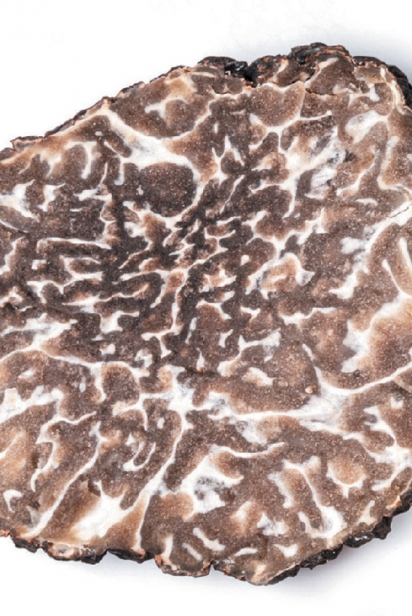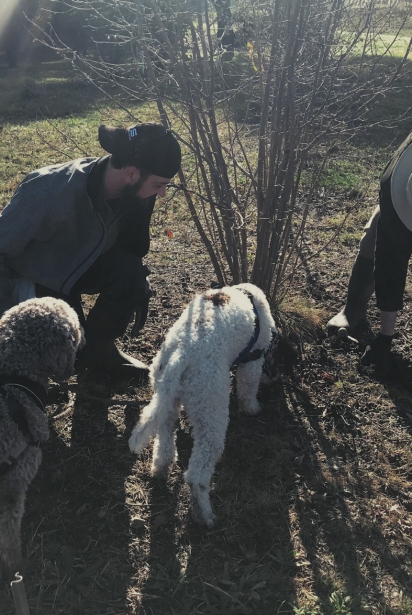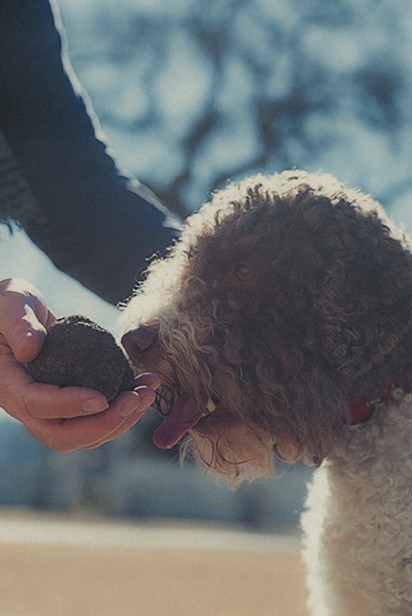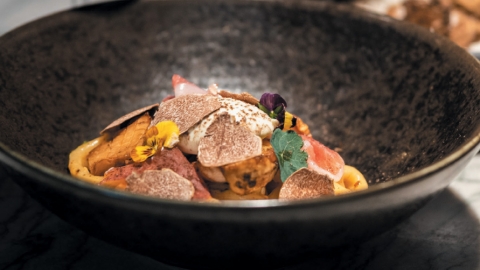The Truffle Gamble
Armed with audacity plus his lucky shovel, Raymond Vineyards proprietor Jean-Charles Boisset stood poised to plant something that might never fulfill its promise.
On this St. Helena parcel in spring 2022, he placed oak and hazelnut trees inoculated with Tuber melanosporum spores. In five years or more, they could begin producing the elusive Perigord truffles, a species prized by chefs and gourmands the world over. Or they might not.
The native Frenchman would be the first to acknowledge the risks associated with what is still a nascent industry in Wine Country. But he reaped success on similar property in Burgundy. There, inoculated trees began producing black truffles after 10 years and now generate about 44 pounds annually.
“We are behind Australia and China,” says Boisset, president of the Boisset Collection, which includes wineries in California, France, England and India. “Americans are the last of the Mohicans. We need to wake up.”
Perigord truffles are an extremely perishable fungus that grows stealthily underground in symbiosis with the roots of specific trees. Boisset is not the only one in this area convinced the gamble of growing them is worthwhile.
The Donum Estate in Sonoma is the latest winery to jump in. Next spring, on five acres of former grapevines in Carneros, 2,000 inoculated hazelnut trees will be planted.
“When you plant a vineyard, you know you’ll get grapes. But you don’t know the quality,” says Dan Fishman, Donum vice president of winemaking and vineyards. “With this, there’s more of a question of failure or success. With so many wineries out there, though, this will make us stand out.”
With its tantalizing musky fragrance, there’s no denying the allure of this luxury ingredient that’s traditionally harvested in France from December to March, then flown across the world to be shaved over voluptuous egg and pasta dishes.
Cultivated truffles from Wine Country, though, face a much shorter trek to Northern California restaurants, a crucial consideration since truffles lose much of their aroma within days after harvesting.
“In the same way that the Judgment of Paris put Napa wine on the map, the same thing will happen in the truffle industry,” says Charles Lefevre, founder of Oregon’s New World Truffieres, a supplier of inoculated trees. “We just don’t know yet who will be the Robert Mondavi of truffles.’’
Like crafting exclusive wine vintages, truffle cultivation is not for the faint of heart or wallet. Besides the cost of the land, it takes about $25,000 per acre to establish an orchard. The exact number of truffle orchards in California is unknown, as no one agency tracks that. Moreover, orchard owners tend to keep a low profile to guard a crop that can command upwards of $1,000 per pound.
If that reminds you of another unconventional agricultural product, you’re not mistaken. In fact, the first person to grow a black truffle in North America was the late William Griner, a Vietnam veteran turned marijuana grower. He achieved that feat in 1987, after planting trees from France on his Mendocino property.
New World Truffieres estimates it has hundreds of customers in California, mostly in Mendocino, Sonoma, Napa, Lake and Marin counties. At least nine of those orchards are now producing, according to Lefevre. That includes a 9-year-old one in Geyserville owned by retired electrical engineer Fran Angerer, who harvested his first Perigord truffle in November 2021, the first ever cultivated in Alexander Valley.
American Truffle Co., based in San Mateo and the United Kingdom, has established more than two dozen orchards nationwide, according to Managing Director Robert Chang. Of those, a third, including Raymond’s, are in California.
This January, American Truffle Co. scored a milestone when a three-acre Napa County orchard owned by Roger Lutz, CEO of Oakville Pump, and his son, Wes Lutz, reaped its first harvest ahead of schedule in only four years. Eight truffles were found, half of them the size of a squash ball—larger than the marble- or golf-ball-size ones typical of a first harvest, Chang says.
Wine Country’s most fruitful truffle orchard is the 10- acre Santa Rosa one established in 2011 by Jackson Family Wines founder Jess Jackson. Planted with Lefevre’s trees, it has consistently produced black truffles since 2017. Last winter’s harvest was 35 pounds, down from a high of 65 pounds in 2019, according to Tucker Taylor, Jackson Family director of culinary gardens, who is now training two Lagotto Romagnolo dogs, a breed famed for truffle-hunting prowess.
Each harvest, a third end up blemished, and are turned into truffle butter featured at winery events. Another third are overripe, and used to re-inoculate the trees. The remaining third are premium quality ones sold to renowned restaurants such as Healdsburg’s Valette and San Francisco’s Benu, Saison, Birdsong, Che Fico and Nightbird for $850 per pound.
Climate change has added to the challenges. Following last winter’s torrential rains, Taylor discovered some truffles rotted in the ground. The threat of wildfires also has necessitated an irrigation system that can be triggered remotely in case of evacuation.
Despite its consistency, the orchard remains unprofitable. “Sure, we wish we would be flooded with truffles,” Taylor says. “But it’s still a relatively new industry. We’re pretty pleased that we’re on the forefront.”
Boisset and Fishman both say that profit is beside the point and support truffle orchards as a way to diversify the region’s grape monoculture.
“We could make $300,000 more a year in profit by planting more Cabernet grapes, and just use that to buy truffles,” Boisset says. “But we want to be a leader in displaying different art forms. Like sculpting and painting, growing is an art form.”
Even so, its value may lie in the eye of the beholder, says Todd Spanier, who has grown dismayed that people have fallen under the truffle spell only to get in over their head. The founder of King of Mushrooms and a gourmet mushroom purveyor in South San Francisco, in 2015 Spanier established California Truffle Orchards in Belmont, an orchard consulting business. He counts more than 20 California clients, most with nonproductive truffle orchards in need of rehabilitation through soil amending, pruning, irrigation and pest control.
Many are hobbyists with no farming background, he explains, who grew mesmerized after attending the Oregon Truffle Festival, started by Lefevre, or the Napa Truffle Festival, founded by American Truffle.
“You can go to these festivals and have a great time,” Spanier says, “but realize the bottom line is to promote the sale of trees. Thousands of trees have been sold, but where are all the truffles? Where are the commercial quantities? I haven’t seen them yet.”
Neither have Fabrice Caporal, a consulting software engineer, and Claudia Medina, an education grant manager. Still, the married couple remain hopeful after funneling their $1 million retirement fund into the purchase of 26 acres in Lake County in 2019 to plant 3,600 of Lefevre’s oak trees. To help cover the cost of electricity and a fulltime employee to trap voracious gophers, they are now building a culinary center to help financially sustain the venture. Opening in spring 2024, it will be available to rent for events.
“Right now, we’re confident that truffles will happen,” Caporal says. “But at some point, doubt will settle in. Then, we will ask ourselves if we want to retire there and just enjoy the land, or do we want to do something else?”
With little to show for a 1¼-acre truffle orchard planted in Sonoma County in 2010, vintner Robert Sinskey chalks it all up to “a nice fantasy, and we gave it a try.” One of American Truffle Co.’s early orchards in Wine Country, it was established in heavy clay soil, which Sinskey concedes wasn’t ideal. Each winter, trained dogs regularly pick up the scent of truffles next to gopher holes, but find no actual truffles, even after thousands of the rodents were trapped. Still, the experience has not soured him completely.
After selling Robert Sinskey Vineyards in Napa in 2022, he and his wife, chef Maria Helm Sinskey, purchased a downtown Napa building for a future restaurant-bakery-tasting room, as well as an 84-acre farm in Carneros that came with an interesting find.
“In the back, the soil is looser and sandier, and Maria thinks it has a more appropriate pH for truffles,” Sinskey says. “It might be worth an exploration. But I won’t promise anything.”
Carolyn Jung is a James Beard Award–winning food writer based in Silicon Valley. She is the creator of the blog FoodGal.com, and the author of East Bay Cooks and San Francisco Chef’s Table.










